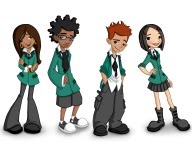Literacy all begins with letters and sounds. But after learning to recognize letters, then words, then phrases, sentences, and even paragraphs, a student’s journey is still far from over. It’s time to make some meaning out of it all. Time for connections. Time to go graphic.
Each of our new forty-four leveled texts come with a graphic organizer, found conveniently in your
Level 2 Resource Guide. Graphic organizers teach students not only how to organize ideas but how to find ideas and meaning in the first place. And according to the
April 2007 Reading in a Foreign Language article by scholars Xiangying Jiang and William Grabe, graphic organizers are especially helpful for English learners, who struggle with meaning more than their native-speaking counterparts. Check out the type of graphic organizers we use and how you can incorporate them into your curriculum.
- Compare and Contrast
- Sequence/Timeline
- Main Idea and Supporting Detail
- Information Table
- Story Map
- Cause and Effect
- Problem/Solution
Struggling readers are likely to see the same text structures over and over without even realizing it. Says Jiang and Grabe, "the limited variety of discourse structures and their recurrence across texts enable teachers to provide explicit instruction to students in text structure knowledge, and students, once familiarized with the major textual patterns, can transfer their knowledge across texts and content areas." Graphic organizers make these text patterns more accessible, so students find meaning easier.
Download a sample graphic organizer
here:





No comments:
Post a Comment
Thanks for stopping by!